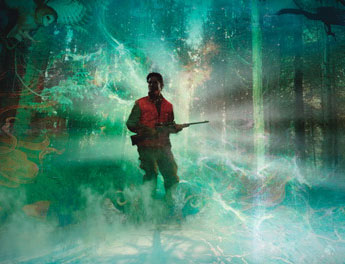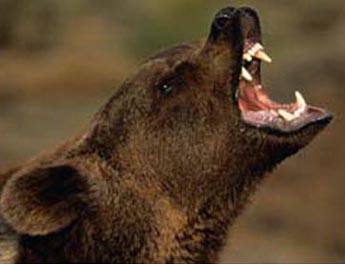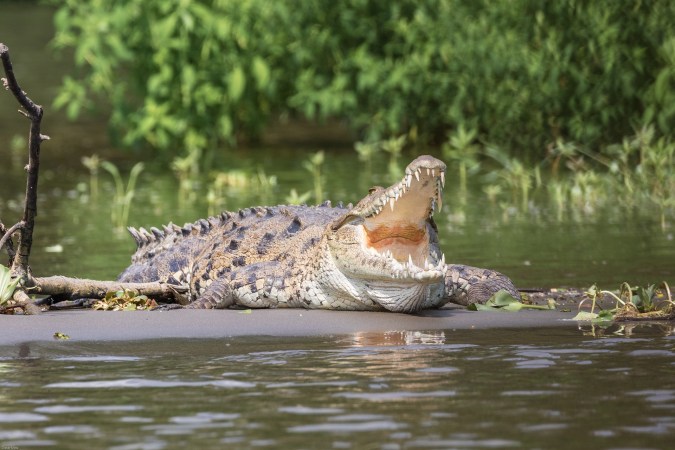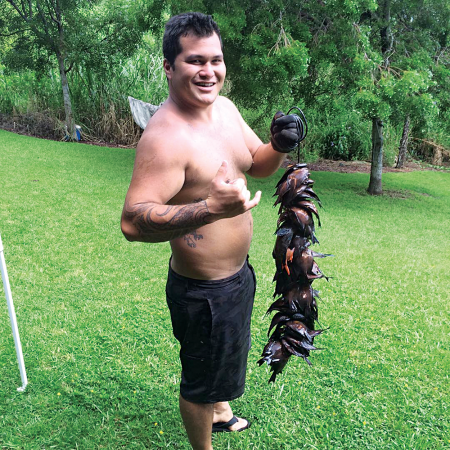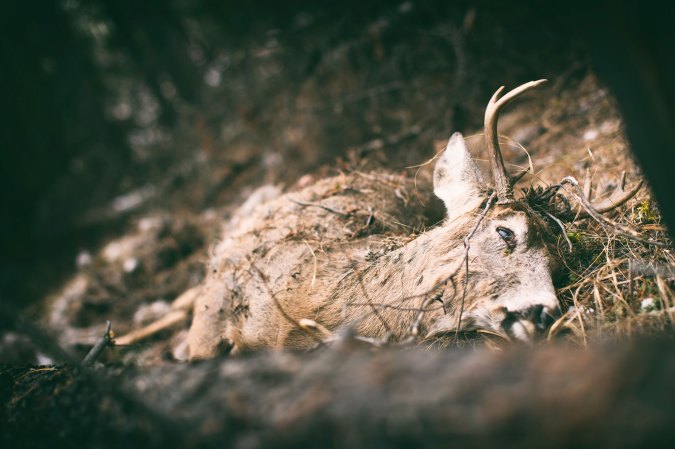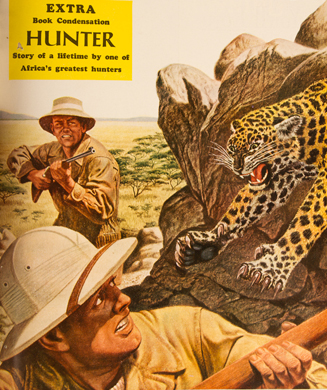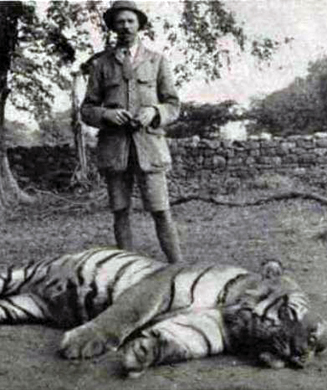ON SEPTEMBER 3, 2003, 51-year-old James P. Rambone Jr. sprinted off across the tundra near the Caniapiscau River south of Kuujjuaq, Quebec, to intercept a caribou bull that he had spotted and hoped to shoot. Rambone never returned.
Other hunters in Rambone’s party later found his fluorescent orange vest and his camera near a caribou carcass, but otherwise there was no gun, clothing or sign that the hunter had ever been there. Several air and ground searches that included tracking dogs failed to locate Rambone. He had completely vanished.
“Bears and wolves don’t eat clothing and wouldn’t have eaten his gun,” says Pam Ruzzo, Rambone’s girlfriend. “A guide who has been working in the area for thirty-five years told me they always find a person–dead or alive, but they always find him.”
RAMBONE, FROM RHODE ISLAND, was participating in what Ruzzo describes as “the trip of his life”–hunting caribou on the rugged tundra of northern Quebec with an outfitter. Most non-native hunters opt to hire a guide for caribou, but Rambone chose an eight-day unguided hunt out of Camp Sardine some 240 miles from the nearest village, confident in his abilities as an experienced hunter and outdoorsman.
No evidence was discovered to suggest that Rambone succumbed to the elements, predators (animal or human) or an accident. He simply disappeared from the face of the earth, or so it seems. Ruzzo still harbors hope that Rambone, an epileptic, is alive.
“For all we know, Jim might have developed amnesia caused by a severe seizure; he might be with someone who doesn’t know who he is and doesn’t realize that he is missing,” she says. “Something’s just not right. You don’t just vanish.”
Hope, speculation and wishful thinking notwithstanding, Rambone seemingly did vanish. His disappearance remains, as a spokesman for the outfitter put it, “an unsolved mystery.”
TIME IS OF THE ESSENCE
Incidents of missing hunters are fairly common throughout North America. Whether they occur in Alaska or the South, there are a couple of common denominators in such cases: Most people who become lost are either ill-equipped or unschooled in the skills necessary to keep themselves safe until they can find help or be rescued, or they are somehow injured or incapacitated and unable to signal rescuers regarding their whereabouts.
Still, of the hundreds of outdoorsmen who go missing each year, most turn up okay after a search-and-rescue (SAR) operation or through their own efforts, usually within 72 hours of disappearing. After three days–especially in cold, wet weather and remote terrain–all bets are off regarding a lost hunter’s safe return.
From 1997 to 2003, for example, the Oregon Office of Emergency Management recorded 336 reports of missing hunters. SAR teams found most of the hunters alive, and 12 dead.
As might be expected, in areas where all sorts of hunting activities are common, the likelihood that hunters will be the target of such searches increases significantly. What is somewhat surprising, however, is that the fate of many missing outdoorsmen is never determined.
It is difficult to quantify the number of missing hunters–rescued or not–because there is no centralized reporting or data collection. According to Megan Bartlett of the National Association for Search and Rescue, “SAR missions are primarily done on the local level and there is no mandate for those local levels to submit their information to a central authority.” Nonetheless, statistics from the U.S. Coast Guard, which performs thousands of SAR missions each year, provide a hint of the ratio of “found” to “missing.”
From 2000 through 2003, the Coast Guard conducted 147,996 SAR missions. Of these, Coast Guard teams rescued 16,175 people and found the bodies of another 3,018. Most of the remainder either rescued themselves or were rescued or found by other parties, but 1,639 people were listed as “unaccounted for.” In other words, nobody knows what happened to them and we can only conjecture. These people simply vanished and are presumed dead.
WITHOUT A TRACE
Most of the Coast Guard’s missions involve weekend sailboaters and fishermen, but hunters figure prominently in the mix. In January 2004, for example, a party of three duck hunters disappeared near Admiralty Island. The Coast Guard recovered the bodies of two of the hunters and eventually suspended the search for the third member of the party. David Mills, 14 at the time, is still listed as “missing,” although SAR teams recovered the bodies of his father, Rich Mills, and a friend, Gary Davies. The hunters’ boat swamped and capsized on the northern point of Kupreanof Island. There isn’t much hope that David has somehow been spared. A Coast Guard spokesman surmises that, for whatever reason, his body never surfaced in the frigid waters of the north Pacific and will probably never be found.
MYSTERIOUS DEATHS
Dozens of hunters disappear in the U.S. each year and are never seen again. Yet sometimes even when the missing are found dead, the circumstances of their demise are shrouded in mystery.
In one famous case in Cherokee County, Tex., sheriff deputies searching for missing hunter Douglas Moore found his body near his pickup truck in the woods. He had bled to death from a single puncture wound that pierced an artery in his leg. On the ground several yards away, deer blood was found.
An unloaded rifle lay near Moore’s body, but there were no spent casings around. Sheriff’s investigators speculated that Moore shot a deer and, thinking it was dead, unloaded his gun before field-dressing it. Then the deer suddenly revived and gored Moore in the leg before making its escape. Adding to the mystery, the deer was never found, despite diligent searches that lasted for several weeks.
In the middle of this past October, in Michigan’s Upper Peninsula, two Sturgeon River fishermen spotted the body of 27-year-old hunter Craig St. John, who had been missing 18 days since he left home on a deer-hunting foray with two friends. The Sturgeon River is swift, though it can be waded with chest waders in the area where St. John’s body was found, his gun still slung across his shoulders.
Initially, investigators speculated that the hunter might have drowned while trying to ford the river, but an autopsy revealed that St. John did not drown, and there was no sign of injury on his body. St. John’s companions said that the three men had become separated during the day, and they didn’t know where he went.
Determining cause of death is more difficult when the body has been exposed to the elements for a long time. As this story was being written, word came that elk hunters found what family members think are the remains of a hunter missing since September 2004. Robert “Bugsy” Springfield disappeared while bowhunting for elk near Bear Hole on the Crow Indian reservation in the Bighorn Mountains of southeastern Montana. He and two companions split up, and he missed a scheduled rendezvous with them. Numerous searches, both official and unofficial, turned up nothing of the man.
One year, one month and three days later, what are believed to be Springfield’s skeletal remains were finally discovered. At press time, the body had not been positively identified, but clothing and Springfield’s wallet containing his identification found with the body convinced family members that it was the missing hunter.
According to Matthew Pryor, Bureau of Indian Affairs special agent in charge of the investigation, rumors had swirled around the nature of Springfield’s disappearance. One version of the story was that he had fled the country. Another rumor had it that Springfield was a robbery victim who was killed to cover up the thief’s tracks. Although foul play has not been proven, evidence found at the scene suggests that it’s possible. One of the hunters who found the body described a belt “neatly rolled up” nearby and a rip in the back of the hunting vest found on the body that “could have been made by a mountain lion or a bullet.” There was no sign of the man’s bow or other gear. Local authorities sent the remains to the FBI forensics laboratory in Quantico, Va., for analysis.
As badly as it ended, cases like the Springfield disappearance reinforce the hopes of other families that they might find some closure. Until then, they wait in silent desperation, not knowing what happened to their loved ones and dreading that they’ll never come home again.
SEARCHING IN VAIN
Tom Howell was the kind of man who went hunting when he took a notion to go, regardless of whether anybody else went with him. He particularly looked forward to a September sheep hunt last fall, after he’d found some good bighorn sign on Limestone Mountain not too far from his home in Caroline, Alberta. Howell drove to the trailhead, took his ATV to the base of the mountain, and then disappeared.
A week later, on the day after Howell’s 47th birthday, his employer notified authorities that the hunter was long overdue, and the search for him began. An SAR squad soon found the ATV where Howell had parked it and covered it and his soft-sided rifle case with a tarp. Between the time Howell vanished and when the rescue effort started, snow had covered the flanks of Limestone Mountain, and investigators could only speculate about which direction he’d taken when he set out from the ATV. Numerous air and ground sweeps ended almost a month later, without results. Howell’s parents, three sisters and two brothers now are resigned to the likelihood that his body is lying somewhere in the vast Canadian Rockies.
“If anything, I hope somebody can find him so my family can have closure,” his sister, Loretta Hilton, wrote in a letter to the Alberta Bowhunters Association, soliciting their help in locating Howell. Hilton’s husband and one of her brothers plan to resume the family’s search for Howell’s remains in the spring after the snow melts.
Likewise, several family members assisted in a massive search for 76-year-old Charles F. Huff, who disappeared the day before Thanksgiving 2004 in Green Swamp Wildlife Management Area in central Florida. The Lakeland man had gone to the WMA to scout for deer and find some good places to hunt with his son-in-law on Thanksgiving morning. When Huff didn’t return home that evening, his family notified authorities. The next day, searchers found Huff’s 1994 white Mazda pickup truck, but no sign of the man. Rain the previous night had wiped out Huff’s tracks and any clues about his direction of travel.
During the next several weeks, hundreds of community volunteers helped state and sheriff’s department SAR teams from several surrounding counties search the 50,000-acre WMA on foot, by boat or helicopter, on horseback and on ATVs–but to no avail. Charles Huff was simply gone. He never returned to his family.
Huff had undergone heart surgery six months before he disappeared; he was borderline diabetic and had a weak knee. All of which led to speculation he might have become ill or unconscious and was unable to respond to the calls of searchers when they combed the area he was in. Florida Fish & Wildlife Conservation Commission officer Kat Kelley said that if Huff had been comatose when searchers looked for him, it would have been unlikely that they could have found him, given the thick brush and grasses of the WMA.
“The area where Mr. Huff disappeared is extremely dense,” she says. “You have trouble seeing four feet in front of you in some places.”
STILL ON THE MOUNTAIN
All so-called “cold cases” with open-ended conclusions are tragic, but one of the saddest involves 31-year-old Jeromy Childress, who disappeared during an opening-weekend elk hunt on Trask Mountain in Tillamook County, Ore., on October 17, 2004.
Childress hunted all day that Saturday with his coworker, Shane Luey, and Luey’s son. After returning to camp that evening, they decided to drive down the mountain’s logging roads collecting enough firewood to last the weekend. Somewhere along the way, they became lost in the dense fog. The men drove around for several hours searching for their camp.
Childress became frustrated and told Luey that he was certain camp was on the other side of a dense stand of trees that could be glimpsed through the fog. Luey agreed and pulled his pickup over to the side of the road. As the trio began walking toward the presumed campsite, Luey’s little boy grew frightened in the dark woods, so his father decided to return to the truck with him. The plan was for Childress to continue on and find the camp, then return to guide them in. Luey watched Childress disappear into the fog. That was the last he ever saw of his friend. After waiting more than an hour, Luey went for help.
An extensive SAR search turned up nothing more than a wrapper from Childress’s favorite brand of chewing gum. A passerby also reported hearing someone firing three rapid shots Sunday evening, which might have been an SOS signal from Childress. Many subsequent searches by dozens of volunteers, including Childress’s wife, Kristen, discovered no further clues.
For days after her father’s disappearance, Childress’s 3-year-old daughter Kelsey asked her mother when he was coming home. “Daddy is still out hunting,” Kristen answered. Finally, after almost a month, Kristen changed her answer. “Daddy is still on the mountain,” she said.
“I have a flashlight,” Kelsey told her mother. “I’ll go find my daddy.”
A STORY WITH A HAPPY ENDING
Fifty-year-old Nick Chillemi didn’t know exactly how he got lost last October during an elk-hunting trip in Colorado’s Black Mountain area, but he knew how he could get found.
Spotting a search helicopter that was sweeping the area, Chillemi used a drink can he was carrying to reflect sunlight and signal a crewman on the aircraft. Once the helicopter veered his way, the hunter was able to wave his arms and get the crew’s attention.
Despite being lost and vulnerable to hypothermia for four days, Chillemi, who lives in Centennial, was examined at an area hospital and given a clean bill of health. –Colin Moore
